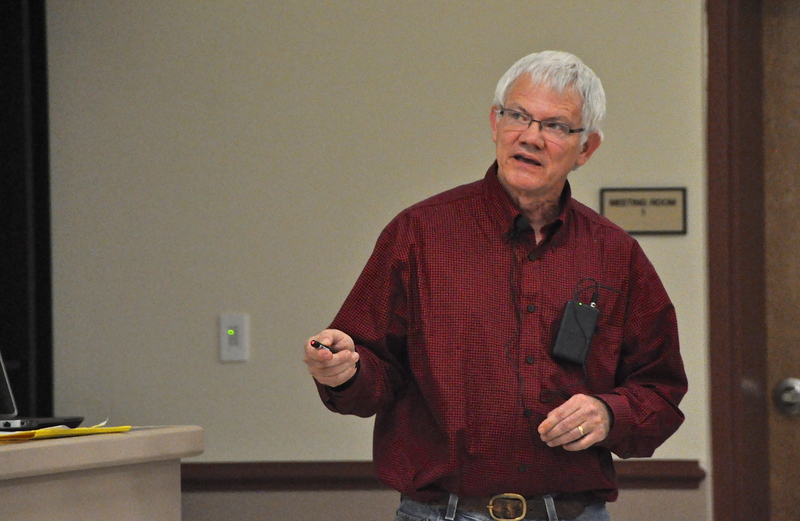Vlasic issues: Trust, plume of pollution
The first crucial step in Allen Harim's plan to convert a former pickle plant into a poultry processing facility is now in the hands of state environmental officials. The 107-acre parcel is part of the state's brownfields program, which means the state assists in cleaning up and redeveloping polluted industrial locations based on an approved remediation plan.
About 125 people attended a Dec. 17 public hearing on the proposed plan designed for the Pinnacle Foods/Vlasic pickle plant near Millsboro. The environmental assessment completed by consultant BP Environmental totals more than 1,050 pages.
Many of those who testified said the remediation plan does not go far enough. They say more testing is needed to determine the extent of what they say is a plume of contaminants migrating from the Vlasic site, threatening nearby wells. Department of Natural Resources and Environmental Control officials say pollution has not migrated from the site.
DNREC staff will review the testimony and make a ruling on the proposed remediation plan. DNREC officials said they could change the plan based on public comments.
If the proposed plan is approved, Allen Harim would be required to follow a brownfield remediation process that includes long-term monitoring of groundwater test wells and drinking water wells at the site. If results show contaminants are migrating or increasing, state environmental officials could require further remedial action.
At issue is the level of contamination at the site. Residents and environmental groups say existing contamination should be cleaned up before discussion of any additional work on the site should take place.
Resident Ken Currie said it's a matter of trust. He questioned why after more than 230 inspections over the past 35 years that DNREC did not find any of the pollutants detected during the BP Environmental site investigation.
“Isn't it reasonable to ask why should residents now believe in long-term monitoring, future permitting and compliance inspections? Will they really result in the protection that we as citizens should legitimately expect from state government?' Currie asked.
“There is a social contract between us and DNREC. We pay their salaries to protect us. Why should we trust them in the future to protect us when they haven't done so in the past? That's a bullseye, because trust is fundamental,” he said.
Questions about arsenic and migration
John Austin, retired EPA staffer and Inland Bays Foundation science coordinator, said chemical migration is already occurring at the site. Austin provided detailed maps that showed evidence of elevated levels of sodium, sulfate and nitrates in residents' wells around the site. “There is evidence of off-site movement of a plume,” he said. “We do not know how far the plume has gone. It will take a lot more sampling because we just don't know. The site has been mismanaged over the years.”
Austin said he has a different view of the data than DNREC officials, especially when it comes to concentration of arsenic in two monitoring wells. “The levels trigger corrective action,” he said.
He said a key area – the location of the pickle plant's wastewater treatment system – was not adequately sampled during the brownfield investigation. In addition, he said, there are no samples taken from soils under a leaking lagoon filled with sludge.
Offsite testing is needed
Cindy Wilton, founder of the citizens' group Protecting Our Indian River, read a detailed report filed by Genell Pridgen, a consultant with Socially Responsible Agriculture Project. The group is acting as a consultant to the local grassroots group.
Pridgen noted that testing done by residents shows offsite migration of hazardous chemicals and an acid plume with a concentration near Possum Point, a community across the street from the Vlasic site.
She said because no offsite testing was done during the brownfield investigation, people can have no confidence that the extent of pollution is understood.
She said the current site has been contaminated by several chemicals including arsenic, chromium, chlorine and nitrates. “In the plan, they are requiring no actual remediation, simply regular monitoring to see if anything migrates offsite,” she said. “What the community needs is for DNREC to complete a thorough quantitative assessment of the environmental pollution emanating from the site. What the community needs is for DNREC to ensure that cleanup is complete before any permit is issued to a new business.”
Pridgen said the impact on the Columbia aquifer from the proposed poultry processing operation would not be sustainable. She said processing and growing up to 2 million chickens a week would require about 530 million gallons of water per year. “Adding this kind of burden to the Columbia aquifer is simply not sustainable and citizens guarantee of safe, sufficient supply of drinking water will not be maintained into the future.”
Lack of information from treatment site
Maria Payan, a consultant with Socially Responsible Agriculture Project, read an assessment of the data completed by environmental engineer Kathy Martin on behalf of Protecting Our Indian River.
Martin said there is a lack of data from monitoring wells to test subsurface soils and groundwater at the former Vlasic wastewater treatment/sludge impoundment operation, including the area where 400 outdoor wooden pickle vats were used.
She said the closest monitoring well is more than 800 feet away and the next two closest wells are nearly 1,000 feet away. In addition, she said, soil borings done at the location did not extend below the depth of the sludge impoundment with a leaking liner. “Any soil analysis would provide no information about subsurface pollutants,” she said.
“It is of utmost importance to document the pollution under the waste treatment area because after the brownfield agreement takes hold, the new owners of this location will only be held accountable for those areas identified in the final brownfield remediation investigation report and remedial plan,” she said.
Sierra Club: A legacy of pollution
“The residents of Millsboro have been disproportionately impacted by the legacy pollution of several current and historic polluting facilities,” said Delaware Sierra Club member Stephanie Herron. “The company should be placed with the burden of responsibility to prove the harmlessness of the redevelopment rather than the burden be placed on the residents.”
During a brownfield investigation earlier this year, several chemicals were found at the site. Samples at a central location showed levels of tetrachloroethene and perchloroethene – both are cleaning and degreasing agents – above the state's drinking water standard, according to DNREC officials. Nitrate was detected in several onsite wells, but the drinking water standard was exceeded in only one onsite drinking water well and two monitoring wells. In addition, lead exceeded the state drinking water standard.
Other chemicals – including iron, cyanide, mercury, methyl acetate and chloroform – were found in soil samples but none present a risk to human health, DNREC officials said.
New plant could provide up to 700 jobs
The Sussex County Board of Adjustment approved a special-use permit for the former pickle processing plant to be converted to a poultry processing plant. Vlasic operated the plant from the early 1970s to 2013; the facility is now owned by Pinnacle Foods LLC. A permit was needed because the proposed use of the facility is considered a potentially hazardous use under Sussex County code.
Allen Harim officials said they plan to hire 700 employees and spend $100 million to upgrade the facility, including construction of a new wastewater treatment plant and installation of a rapid infiltration basin system for discharge of treated wastewater.
The Millsboro Chamber of Commerce, the Sussex County Association of Realtors and the Delaware Assoication of Realtors have voiced support of the plan.
During the hearing, James Baxter IV, a Millsboro farmer, was the lone person who testified in support of the plan. “I know that's not part of the conversation tonight, but there are 700 jobs going to be created in this county. Let's put our children to work,” he said.
























































